Spending a day with a precision farming specialist for this regular feature is always an adventure. My latest experience took me to west central Minnesota and an eventful 10 hours with Matt Rohlik, Integrated Solutions Manager at Haug Implement.
Rohlik joined the John Deere dealership 6 years ago and works out of the Willmar, Minn., location, which houses all 4 of the company’s precision farming personnel. The dealership also has a second location in Litchfield, Minn., about a half-hour west of the flagship store.
In a segment of the ag industry where turnover is high and technical experience is a sought after commodity, Matt prides himself on blending business savvy and progressive precision expertise to serve farm customers.
“Farmers trust specific people,” he says. “Number one is their banker. Number two is their crop insurance agent. Number three is their accountant and number four is their precision farming specialist. That’s the list of our customer’s most trusted advisors.”
Being part of the inner circle is the linchpin to lasting business relationships, and I was fortunate to get a taste of how Matt leverages his diverse knowledge of precision farming technology to gain and maintain business for the dealership.
Whether balancing 120-feet in the air to troubleshoot an RTK signal, demonstrating the tangible benefits of owning an unmanned aerial vehicle (UAV) or tracking a customer down during harvest for a warranty claim signature, Matt was always on the go, with a goal of keeping customers satisfied and the dealership profitable.
6:10 a.m. My cell phone alarm goes off in the hotel room. Rather than subject myself to a 7-hour drive through the night from Milwaukee, I decided to get a good night’s sleep at the Holiday Inn Express in Willmar, about 1 mile from the dealership.
6:40 a.m. I assemble a delicious, if not well-rounded breakfast, in the hotel lobby consisting of sausage, bacon, a warm sweet roll and coffee. Matt says he usually gets to the dealership office about 7 a.m., so I refill my coffee and jump in my rental car to meet him.
7:02 a.m. I arrive at Haug Implement, which opened its Willmar location in 1972. Business is already brisk this morning, with several customers at the parts counter and phones ringing in several offices. The showfloor isn’t spacious, but it’s accessible and an array of farm equipment is outside on the lot.
7:05 a.m. Matt finds me and we head upstairs to his workspace, which is bordered by GPS receivers and monitors, but nevertheless organized. He is one of four integrated solutions employees (AMS) at the dealership. I’m introduced to Derek Haupert, precision farming consultant, who joined Haug in May. Derek specializes in non-Deere precision sales and service. He and Matt are going over pricing for Ag Leader’s new 8-section downforce control system on a customer’s planter.
This being Derek’s first harvest, he primarily handled yield monitor calibrations, while Matt took care of more complex service calls. “We charged out Derek’s time and mileage and none of our customers balked at it, so he must be doing a good job,” Matt says. “This is probably our last crazy week for harvest.”
7:35 a.m. Matt returns an email from an instructor contact at Lake Area Technical Institute in Watertown, S.D., to confirm his attendance at a career day later in the week. Matt is a graduate of South Dakota State University, which is one of several educational institutions he works with to recruit talent through internships or campus visits. “This is a very high turnover industry and it’s not always easy to get people to stick around,” Matt says. “It’s good for us to have a presence and a relationship with colleges to develop new people.”
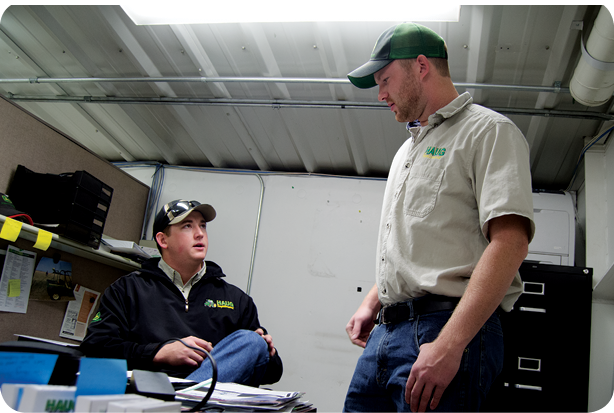
Mentoring is a priority for Matt, whether it’s working with a new hire or taking the time to speak at colleges or universities, partly as a recruitment tool for the dealership.
7:47 a.m. We go over the tentative plan for the day, which will take us through the southern part of the Matt’s service area. Between the 2 store locations, he covers about a 60 by 90 square mile radius. Typically, he tries to schedule a handful of customer visits on his way to the dealership in the morning, which is about a 20-minute drive from home. “I don’t typically spend a lot of time in the office. My general rule of thumb is I won’t answer the phone before 6 a.m. or after midnight, unless it’s an emergency,” he says.
8:01 a.m. After grabbing some necessary hardware and tools for the day on our way out, Matt pops into the office of Neil Graves, store sales manager, to briefly discuss a plan to include some older precision equipment in an upcoming equipment auction. The conversation lasts a little longer than expected, but Matt, Derek and I eventually hop into the service truck and get on the road.
“It’s almost impossible to leave on time,” Matt says.
I jump in the passenger seat and Derek sits in back. A pad of paper sits in the center console on the dashboard, and a coffee mug filled with sunflower seed shells, two bottles of water, business cards and a couple of pens fill the cup holders. Matt grabs a handful of sour gummy worms from a bag next to his seat, and the snack suffices as an early breakfast substitute.
8:15 a.m. Our first scheduled stop is to diagnose an error code on a customer’s AutoTrac guidance system in their John Deere 7830 tractor. Matt usually tries to plot the most efficient route when visiting customers and knows how to navigate his area extremely well. Nevertheless, he’s put more than 76,000 miles on his service truck since 2011.
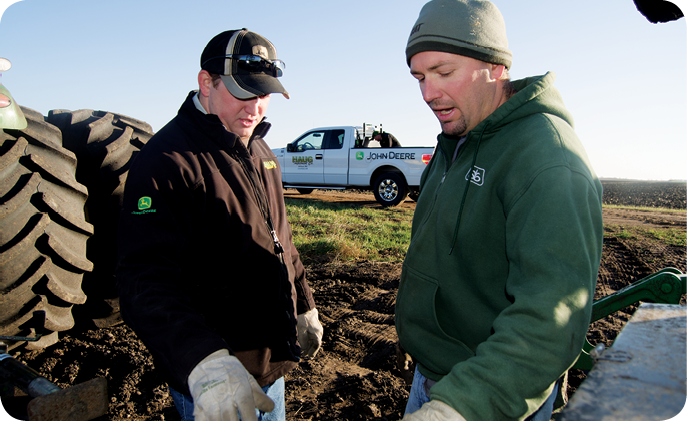
Matt explains to operator Matt Loppnow that a wiring issue is causing shut-off problems on an anhydrous application system, which will eventually require a new harness. “In a situation like this, I write down the mileage, my truck number and charge it out accordingly for the service,” Matt says.
“One of the capabilities we have is that there is GPS vehicle tracking on every one of our service trucks, so we always know where our techs are,” Matt says. “So if someone is 3 miles away and I’m a half-hour or more out, I’ll see if they can stop by or meet me with parts that I’ll need for the job.”
8:21 a.m. We get a call from Mike Yost, who is having trouble with Raven’s AccuFlow anhydrous system on his John Deere 2410 chisel plow and the rate controller in his John Deere 9560R tractor. Matt notes that this customer has had recent problems getting the system to shut off and recently replaced the flow meter.
Matt gets his location in the field, which is about 20 minutes away in Kerkhoven, Minn., and we head in that direction. “Looks like our schedule has already changed a little bit,” Matt says.
8:40 a.m. We find Matt Loppnow, an operator for Mike Yost, waiting for us in the field. It’s sunny, but a brisk wind puts a cold bite into the morning air. He tells us that he can’t get the anhydrous to shut off and Matt investigates the wiring on the anhydrous system and then climbs into the tractor cab to check the settings on the 2630 display. Despite the circumstances, Matt and Matt share a few laughs while trying to diagnose the problem.
9:25 a.m. Derek and I stand clear as Matt tests the system. A white puff of anhydrous billows into the air and we catch a whiff of the unmistakable scent. Satisfied with the initial test, Matt Loppnow puts the anhydrous shanks back into the ground and makes a pass through the field. We get the thumbs up and jump back into the truck. “All of the sudden, it’s almost 9:30,” Matt says, when he looks at the clock.
The problem ended up being a wiring issue in one of the cables, which Matt was able to solve for the short-term. But the system will need a new harness before next year.
“In a situation like this, I write down the mileage, my truck number and charge it out accordingly for the service,” Matt says. “Unless I’m going to see someone specifically for a sales call or to demo equipment, every time I leave the shop with my truck, hopefully I’m capturing revenue for the dealership.”
9:42 a.m. We make a pit stop at a corner gas station where Matt picks up a bag of dill pickle sunflower seeds, a Mountain Dew and a bottle of water. “I didn’t eat breakfast,” he says. The hotel breakfast and coffee are still holding up for me, so I take my chances that we’ll be eating lunch at some point later in the day.
9:52 a.m. Matt is having an area behind his house leveled for construction of a cattle barn, and we drive by so he can check on the progress. He farms about 30 acres and says someday, he may try and expand the operation. “Right now, I don’t want to compete with my customers, so I’ll wait until I’m retired before I think about doing any more.”
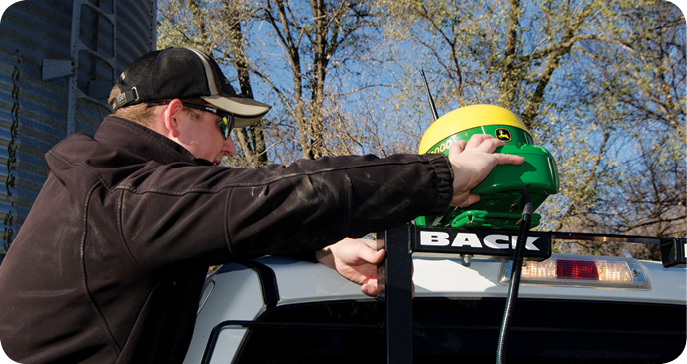
To test the signal strength of an RTK tower, Matt attaches a GreenStar 3 receiver to his truck and monitors the consistency of the signal for at least 10 miles.
10:00 a.m. Satisfied with the progress at home, we head to Randy Hebrink’s farm in Renville to troubleshoot the error code on his AutoTrac system. We find his tractor in the shed and Matt calls into the dealership to relay the error code and determines that Randy will need to replace a valve to engage the system.
For this type of service call, Matt considers himself more of a “customer service representative” because he is responsible for informing the customer and the dealership of the problem, and then coordinating a fix.
“Being well versed in equipment parts and service, I’m able to line up this type of job, which is going to be a $1,500 service call,” he says. “It’s a ‘quiet’ sale for the dealership because it’s bringing in revenue, but it’s not something that anyone outside of the service department is going to be involved in.”
10:37 a.m. Our next stop is only a few miles away, but one which Matt hoped we could have gotten to earlier in the day. A customer is having trouble maintaining the signal from one of the dealership’s RTK towers attached to the top of a grain bin.
“It’s a lot windier now, so it would have been nice to climb to the top earlier, but at the same time, nobody is down because of the RTK tower,” he says. “It’s about prioritizing who needs help right away and who can wait.”
Matt ties a new RTK antenna and coaxial cable to a rope and makes the 120-foot climb to the top of the bin. “You definitely can’t be afraid of heights for this part of the job,” he says.
On the ground, Derek and I check reflectivity, which measures the distance of the signal. The customer subscribing to the signal was only getting 3 miles of coverage, when he should be getting about 12, Derek says.
10:55 a.m. Several tests of the existing RTK antenna don’t indicate any problems and Matt suspects that moisture in the connection may be what triggered the weak signal. To be sure, he attaches a StarFire 3000 receiver to the top of the truck and connects it to the 2630 monitor to test the signal range.
11:04 a.m. The signal remains strong as we get about 10 miles from the tower and we decide to head to our next call, which is another RTK tower check about 4 miles away. Matt says RTK subscriptions sales alone have been a “break even” venture for the dealership, but they have created additional revenue through service and sales of new equipment.
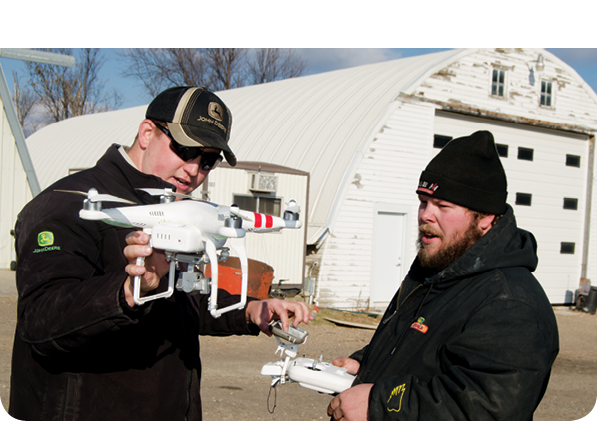
Unmanned aerial vehicles are a “sexy” product to sell and Matt successfully demonstrates the features and functions of one for Chris Enestvedt. “I’m much more interested in the service side, but the UAVs are the attention grabbers,” Matt says.
11:15 a.m. Before Matt heads to the top of the grain bin, he decides to remotely get a closer look at the tower using a DJI Phantom 2 Vision Plus. The dealership began selling the UAVs in late spring and Matt has about 200 hours of flight time on the product. In this case, he wants to get a visual of the tower setup so he knows what tools to take up.
“These are still toys more than tools, but I’ve used one to fly my crops, cattle pastures and for grain leg inspections,” Matt says. “I don’t like selling anything to our customers that I haven’t tested.”
11:27 a.m. Matt fills a bucket with supplies including clamps, wrenches and electrical tape to haul to the top of the grain bin, along with a new RTK antenna and coaxial cable. This climb is more tedious than the last one because of landing platforms every 30 feet and the antenna gets caught on metal brackets around the steps. Matt eventually reaches the top and plugs into the signal, which Derek and I again check on the monitor. This time, it’s well above the normal range for reflectivity.
Matt starts by changing the coaxial cable, and this does the trick. The reflectivity reading drops back into an appropriate range. Matt double-checks the readings and also raises the antenna a few more feet. From my vantage point, this looks like a treacherous and taxing job. Matt is standing on the first rung of a guard railing 120 feet in the air trying to steady and lift a metal pole one notch at a time in a swirling wind.
11:41 a.m. Finally back on the ground, Matt is noticeably fatigued and takes a couple moments to regroup. “That took a lot out,” he says. “These jobs are always a good reminder that I need to get into better shape.” We pack up and hit the road, again testing the signal strength, which is strong as we pass the 10-mile mark.
12:10 p.m. After a busy morning, it’s time to grab lunch and we stop at Max’s Grill in Olivia. Typically, Matt says he doesn’t eat in for lunch, especially during peak times of the year, but the schedule allows for it today.
He orders a chicken tender sandwich with kettle chips. Derek gets a cheeseburger and chips, and I get a barbeque salmon wrap with chips. “Usually, we do get time to eat, and I’ll just get fast food to keep going,” Matt says. “There’s a few times each week we’ll get to have a proper meal.”
12:45 p.m. With full stomachs, we get back on the road and head near Sacred Heart, which is about 15 miles away to do a UAV demonstration for a customer. On the ride, we pass several smaller farm operations and Matt tells Derek to take note and consider making visits to them in the future. Earlier in the year, Matt had Derek make close to 200 “cold calls” to farmers that the dealership rarely hears from to see if they needed anything.
“These weren’t our typical customers and Derek did drum up some equipment sales through those visits,” Matt says. “Our precision team is always in the field, so we hear from customers and can relay information to our sales team. It’s going to get tougher in the next couple of years for sales, but there are still deals to be made. It’s precision equipment that is going to separate the men from the boys when times are tough, because farmers will want to micro-manage from a farm basis to a field basis and want to know if that field is making them money.”
1:12 p.m. We arrive at Dean Enestvedt’s farm and he lets us know that he’s going to pick up his son, Chris, to bring to the demonstration. The farmers are loyal Case IH equipment users, but Matt says their interest in UAVs is a good entry point for him and the dealership. While we wait, he gets the UAV set up and does a test flight above the grain bin.
The UAV is still in the air when Dean and Chris get back, and it’s obvious they are intrigued by the technology. Matt lands the UAV and the Enestvedt’s dog closes in on the quadcopter, before Dean ushers it inside their machine shed.
1:31 p.m. Matt gives a detailed presentation of the UAV’s features and capabilities during the flight demonstration. Dean and Chris ask several questions about battery life, image resolution and restrictions. Matt advises them as long as they keep the UAV below 400 feet and within line of sight, they won’t have problems. He then turns the controls over to Chris who flies one of their fields and checks the images on the Matt’s iPhone attached to a harness on the joystick. Matt quotes Dean and Chris a price of $2,150 for the complete UAV system and shows them everything that is included with the purchase.
1:45 p.m. We finish up and thank Dean and Chris for their time. When we get back to the truck, Matt is optimistic that they will buy the system. “We’ve done flyovers with the Phantoms and they’ve sold and paid for themselves in one field on one flight,” he says. “I’m much more interested in the service side, but the UAVs have the sex appeal and are the attention grabbers. Ultimately, farmers still want to know what their return on investment is with this technology.”
2:31 p.m. Matt wants to stop by his house again after getting a call from the contractors who are leveling his field. He was hoping they would be done with the job in one day, but it doesn’t look like that is going to happen. They’ve made considerable progress since this morning, with about 75% of the area cleared. Matt gets an update from one of the contractors, while another worker is driving a John Deere Scraper-Special tractor. We learn that it’s the operators first time driving the machine and Matt says he’s never seen the equipment in action.
“We’re a Scraper-Special dealer, but this is the first time I’ve seen one working,” he says. Once the land is leveled, Matt is going to have concrete poured, so he puts the UAV to use again to get an aerial view and measurements of the area.
3:21 p.m. We’re back on the road and Matt calls Jim Hebrink to see if we can stop by his farm to get a serial number off a sprayer to complete a warranty claim, since we’re nearby. Jim is in the field harvesting corn, but lets us know we can find the sprayer at his son Jeremy’s farm.
3:44 p.m. Matt gets the serial number, but we have to find Jim in the field and have him sign the claim so it can be processed. Matt knows the Hebrinks well and wants to complete the job today.
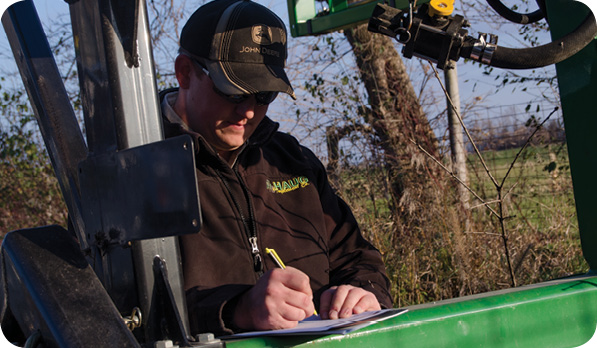
Something as simple as getting a serial number off a sprayer to process a warranty claim is a job Matt takes pride in doing for customers, because it helps solidify a lasting business relationship.
4:17 p.m. We pull into a partially harvested cornfield and Matt says he prefers not to take his truck through the cornstalks because of the potential tire damage. But Jim is in the middle of the field and it’s easier for him to see us. Two combines are harvesting Jim’s last 50 acres of corn and Matt flags him down and hops into the cab. They make a couple of passes and Matt returns to the truck with the signed papers.
4:31 p.m. Although the temperature reading in the truck claims it’s 44 degrees outside, it feels a lot colder as the sun is setting. Matt calls the dealership on our way back to get a price quote on a new gearbox for his own baler, which broke down in the field. His best option is to overnight the $1,700 part from another location and he decides to do it, rather than wait.
5:11 p.m. The dealership is still relatively busy as we pull into the lot. Derek unloads the supplies from the back and Matt and I head inside. He introduces me to the third and fourth generation owners, Butch Haug and his son Paal.
5:23 p.m. Butch invites Matt and I to his office upstairs and is excited to show us an amusing YouTube video of a mini excavator loading itself onto the back of a truck. We share a laugh, and Matt gives Butch a recap of our day and the two discuss their agenda for the rest of the week. Butch notes that a priority for him is finishing the James Collins’ book, “How the Mighty Fall,” which offers strategic insights on how successful businesses can survive decline. He notes that the book will be particularly relevant in the ag industry in the coming years and it’s “required reading” for managers at the dealership.
5:31 p.m. We head back down to the showroom and it’s much quieter, given that the dealership technically closed at 5:30. I thank Matt for an eventful day and we part ways. I hop into my rental car and make the short drive to the hotel after another successful Day in the Cab.




![[Technology Corner] A Big Step Forward for Interoperability & Data Sharing](https://www.precisionfarmingdealer.com/ext/resources/2025/12/12/A-Big-Step-Forward-for-Interoperability--Data-Sharing.webp?height=290&t=1765565632&width=400)


